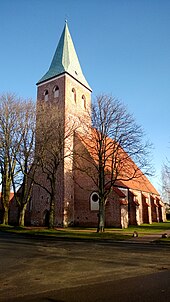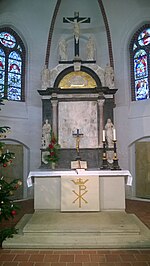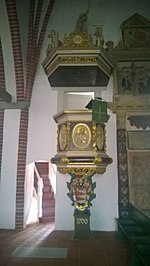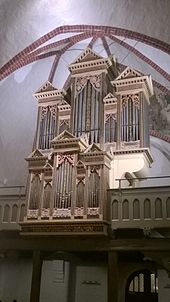St. Mary's Church (Plate)
Coordinates: 52 ° 58 '47.8 " N , 11 ° 8' 7.7" O The Lutheran St. Mary's Church belongs to Parish Plate in Kirchenkreis Lüchow- Dannenberg the Landeskirche Hannover .
location
The church is located in the middle of the village on a flat elevation on an almost round church square surrounded by a street. The place and the church are in the Jeetzel lowlands and were originally a swampy area.
history
The origins of the Plater Church go back to the 13th century. The main nave, with its mighty walls and round arches, has a Romanesque architectural style. The floor plan in the form of a lying cross and a towerless building suggests a Cistercian foundation . In the Medingen Monastery there is a picture of four Cistercian women who are received by a widow in Plate. In Plate these four Cistercian women and the widow appear again on the mural “The Last Judgment”.
According to a legend, one of Plato's got lost while hunting. He found an image of the Virgin Mary on the site of the present church, which inexplicably disappeared when he got home. He vowed to build a church at the site. The image of Mary was found in its place of origin, and that of Plato fulfilled his vow and had the church consecrated to the Virgin Mary.
From 1370 onwards, five brothers from the von Plato family expanded significantly in the Gothic style. The tower with two bells is built, the side aisles are expanded and the Gothic star vault is created. The typical signs of the construction huts can still be found today in the masonry. The rood screen was probably also built around this time.
The triumphal cross above the rood screen was carved in 1450. After the Reformation, the triumphal cross and rood screen were created from the church and in 1900 the triumphal cross came back to its old place.
The last major expansion of the church took place from 1472 to 1492. The sacristy is built and the aisles are pulled forward and connected to the tower.
At that time, the church was a place of pilgrimage , also because a healing spring rose in its vicinity, after which miracles are said to have happened. In 1494, Günther von Plato had Pope Alexander in Rome confirm the events in Plate and obtained another permit for an indulgence . At the Kirchweih festival in early August for the Petri chain celebration, a fair was celebrated and indulgences were granted against sacrifices for the church. After the Reformation , the fair had to be banned because popular belief did not want to give up pre-Reformation beliefs.
The Reformation was introduced in 1530. The first Protestant pastor was the Catholic pastor, who had looked after the congregation in Plate since 1520.
Since it was built, the church has been the burial place for 69 members of Plato's founding family and people who were related to the church. Three tombs were built next to the tower in the side aisles after 1668, when burials in the church ceased, and in 1801 burials in the church were completely stopped. The family v. Plato has owned a private cemetery in Grabow since 1953.
The families v. Plato (Obergut) and v. Blottnitz (Untergut) take turns in exercising the patronage . Since 1372 there have been 41 cartridges to date. Until 1848 they were the sole masters of the parish and paid the pastor and sexton. Then they gave their duties and rights to the regional church.
The swampy subsoil repeatedly caused dislocations and cracks, which made costly renovations necessary (1900, 1957, 2009–2011). Arnold Woldemar von Frege-Weltzien , who married into Plato's family, donated a large amount for the extensive church renovation in 1900 .
In 1880 the parish had over 1200 members. Today (2011) there are a good 1000. The number of parishioners could be kept fairly stable due to the numerous new building areas in the villages, while the relative proportion of church members decreased sharply.
architecture
The church is a strikingly large three-aisled brick building for a village with a polygonal choir and a converted west tower. The church is almost 35 m long, over 23 m wide and the central nave is ten and a half meters high. The tower is 42.10 m high. The church is more elaborately built and richer than other churches in Wendland.
Outer walls
As a result of the repeated extensive repairs that were required by the soft subsurface, much of the exterior masonry has been replaced. This can be recognized by the structure of the wall and the neo-Gothic windows of the nave.
inner space
The interior has two architectural transitions:
- Architectural style: The arcades between the main nave and side aisles still have Romanesque round arches, but the vaults are already Gothic ribbed vaults, both the star vaults of the main nave and the ribbed vaults of the side aisles.
- Cross-section of the nave: The vaults of the central nave are almost at the same height as those of the aisles, making it a stepped hall . Because the central nave is almost twice as high as the side aisles, the spatial effect of a pseudo-basilica is created .
Furnishing
Altar and pulpit
The altar and pulpit were donated at the beginning of the 18th century. Both were built in the baroque style.
The altar is made of black and white alabaster . The Lord's Supper is shown in the center. Above it stands a crucifixion group with Mary and John next to the crucified one. In between there is the word " Yahweh " in Hebrew in a golden halo . To the side there are statues of the four evangelists.
The triumphal cross is built in the choir arch with a crucifixion group at the point on a transom where the rood screen used to stand. The richly decorated pulpit is surrounded by medallions of the evangelists and Jesus. The coat of arms of the Plato family is incorrectly depicted on the base. The risen Jesus with angels stands on the cover .
Epitaph, tombstones and tomb
Next to the pulpit an epitaph for Christoph v. Plato and his wife attached.
After the church was no longer used as a burial place, six tombstones were placed in the wall of the choir. There are u. a. the married couple Parum and Christoph von Plato and Joachim von Plato.
On the west side there were tombs at the end of the two aisles. There is one crypt on the north side and two on the south side. In 1968 the crypts were cleared by order of the district administration and the coffins opened improperly. An oil tank was installed in south crypt 3 and a storage room and toilets in north crypt 1. In the south crypt 2 are the ceremonial coffin of Sophia von Plato, b. v. Quitzow (1691–1715) and the coffin of Ernst Anton von Plato (1679–1724), who also donated the altar.
fresco
A large fresco from around 1450 was found behind the organ during the renovation in 1900. It depicts the “Last Judgment”. Jesus Christ is enthroned in the center, Mary to the left and John to the right. The hellhound draws the evil people to hell on the right. On the other hand, you see the good people after the resurrection. The four Cistercian women and the widow below can be found here.
organ
The organ was evidently built in the 16th century, the architectural style of the organ front speaks for it. It was given to the church by the patronage family. It has not yet been possible to determine with certainty whether the organ was originally built for this church. In any case, in 1603, master organ builder Hellwig worked on the Renaissance organ. He was brought from Danzig and Thorn for this purpose. The organ at that time could have had 30 stops or stops. The year 1609 on the Rückpositiv probably does not correspond to the year of construction of the organ. The year could be an indication of a renovation, a conversion of the organ to Plate or at least a new painting.
The organ was destroyed in 1638 during the Thirty Years' War . The organ builders Justus Kayser from Celle and Johann Kahle from Fallersleben repaired the organ from 1667 to 1669. In the course of the next two hundred years, several other organ builders worked on this organ, including: a. 1686 Johann Balthasar Held , probably Johann Georg Stein in 1757 and Friedrich Fleiter in 1868 .
At the end of the 19th century the organ was in poor condition and was rebuilt in 1900 by the company Furtwängler & Hammer from Hanover. Behind the historical organ case with the prospect pipes, which are still original today, a modern organ with pneumatic pocket drawers with 15 stops on two manuals and pedal was created .
The Hillebrand brothers' organ workshop built a new two-manual organ with 13 registers and mechanical slide chests in 1981. After the organ case had been restored from 1998 to 2003, the company was able to carry out several fundamental works in 2014, with which the organ received a new intonation according to sound parameters of the 16th century. All metal pipes are made of hammered metal. The temperament of the organ is modified to mean tone ; the pitch about a semitone above normal.
The arrangement of the organ is as follows:
|
|
|
||||||||||||||||||||||||||||||||||||||||||
Bells
Two bells have been documented in Plate since 1628. The age of the great sugar loaf bell is assumed to be 500 years. The small bell dates from 1350. In 1685 the large bell was cast around and the bell of the Reitz church was added, so that this bell weighed 763 kg. This bell broke in 1842, was re-cast, smashed in 1917 and melted down for war purposes. In 1927 the parish bought three iron bells from the Schilling-Lattermann foundry . Since then, the parish has had four bells, which traditionally strike three times a day to ring prayer.
The three iron bells were replaced in 1991 by new bells from the Metz foundry in Karlsruhe.
| number | Weight | diameter | volume | Casting year | inscription |
|---|---|---|---|---|---|
| 1 | 500 kg | 883 mm | a 1 | 1991 | Glory to God in the highest |
| 2 | 300 kg | 768 mm | c 2 | 1991 | and peace on earth |
| 3 | 250 kg | 692 mm | d 2 | 1991 | the people of his pleasure |
| 4th | 135 kg | 600 mm | e 2 | 1350 |
Bell I also bears a Christ monogram on one flank and opposite the lines: "Because mountains should give way and hills fall, but my grace should not deviate from you and the covenant of my peace should not fall". The donors of this bell remember the former pastor Wörmer with an inscription, who organized the renovation of the church in 1900.
Trivia
- The parish of Plate includes the places Lübeln , Reitze , Belitz , Beutow , Grabow , Lüsen , Gollau , Müggenburg and Plate .
- The Marienkapelle in Lübeln was taken over by the municipality of Lübeln.
- In Reitze there was a Laurentius Chapel , which was torn down due to dilapidation and not rebuilt.
- The parish and parish house is a large neo-Gothic building near the church.
- The old school building in Plate also belonged to the parish.
- The church bells ring three times a day to ring prayer .
- On the south side of the church is a six-part memorial for the soldiers from the community who died in World War II .
On the back of the stones is written: "There they / their swords / will make plowshares / and their spears / sickles / saith the Lord (Isaiah 2)" .
proof
- ↑ Wolfgang Jürries (Ed.): Wendland-Lexikon. Volume 2, Lüchow 2008, p. 237.
- ↑ St. Mary's Church in Plate. P. 1 f.
- ↑ St. Mary's Church in Plate. P. 1 f.
- ↑ The Hannoversche Wendland - churches and chapels. S 120.
- ↑ St. Mary's Church in Plate. P. 4 f.
- ↑ Elbe-Jeetzel-Zeitung: The patronage crypt of the Plater church. August 31, 1968
- ^ Church, tombs and patrons. P. 11, p. 16.
- ^ Church, tombs and patrons. P. 19.
- ↑ Churches and chapels in Wendland. P. 30 f.
- ↑ St. Marien in Plate on the organ music page NOMINE - with numerous photos of the interior
- ^ Church, tombs and patrone , p. 15 f.
- ↑ Axel Fischer: Organ of the Hillebrand brothers (1980/81) in the historical case (16th century) , accessed on November 6, 2014.
- ↑ Axel Fischer: The Renaissance organ.
- ↑ Churches and chapels in Wendland. P. 101.
- ↑ Online project monuments to the likes
literature
- Ernst-Günther Behn: The Hannoversche Wendland - churches and chapels. Köhring Verlag, Lüchow 2011, ISBN 978-3-926322-50-0 .
- Doris Schmidtke: The churches in the Lüchow-Dannenberg district. Page 183–189 in Klaus Poggendorf (Ed.): Das Hannoversche Wendland. Lüchow-Dannenberg district (self-published), 3rd edition, Lüchow 1985.
- Alfred Kelletat: Churches and chapels in Wendland. Breese im Bruche 1981.
- A. Wörmer [A. = August]: The church at Plate. Parish of Plate 1901.
- Anton Detlev v. Plato: St. Mary's Church in Plate. Parish of Plate 1988
- Eberhard v. Plato: Church, tombs and patrons. Köhring Verlag, Lüchow 2010.
- Axel Fischer: St. Marien Church Plate - The Renaissance organ. Parish of Plate 2014











